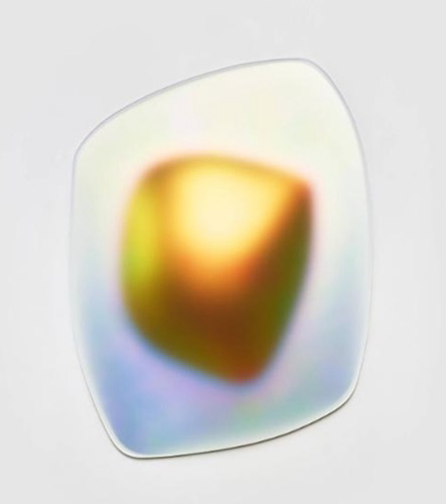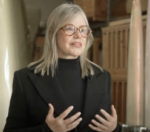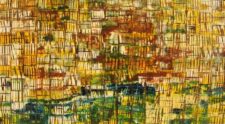
Gisela Colón
Canadian, 1967 (active USA)
Skewed Square (Phosphorus), 2022
blow-molded acrylic
54 × 42 × 12 in.
SBMA, Gift of Eugene Fu
2023.15

Gisela Colón, photograph from KTLA interview, 2024.
“The blue planet in movement and the energy we all share includes the ability to look beyond what is tangible to what is possible.” - Gisela Colón, 2024
“All of my recent pieces are a continuum of my practice of organic minimalism but extrapolated and extended into the natural world.” - Gisela Colón
RESEARCH PAPER
Skewed Square (Phosphorus) is the amalgamation of line, shape, form, value, space, color, and texture moving rhythmically in harmonious union. Using the physical properties of light, specifically optics, Gisela Colón coalesces science with art in her work. In Skewed Square (Phosphorus) Colón refers to it as Organic Minimalism. However, her work is anything but minimal. It is the complex characteristics of light and space fused into virtual Kinetic Art inviting you to see the effortless effects of the movement of light as art itself.
As you walk around the piece, Colón engages you in a spectrum of refracted light that needs to be viewed slowly from different angles. Like a giant mood ring, the bulbous protrusion of acrylic on board generates prisms of color and corresponding emotions.
Colón understands that light rays bend (refract) as they pass from one medium to another. Prisms of color are formed depending upon the type of material, the number of layers of the material, and the angle at which light rays bend and fold as they pass through the layers of the material. Skewed Square (Phosphorus) is a marvelous example of the science of refracted light.
To achieve this effect, Colón works with her team at her studio in Duarte, CA. Using a wooden form, Colón creates a model of multiple layers of shaped acrylic to capture and refract light. This technique creates a magnificent prism of light that shifts its rainbows of color when viewed from different angles and perspectives. With the biomorphic pod series, as with Skewed Square (Phosphorus), her team curates each piece based upon her sketches and guidance with each piece taking a few months to a few years to complete.
Born in Vancouver, Canada, in 1966, Gisela Colón and her family moved in 1967 to Puerto Rico, where her father, a chemist, monitored air quality for the government. The scientific curiosity which nurtured her discovery of unique artistic materials was inherent in her family—her grandfather, a cartographer, and both grandmothers were scientists, a pharmacist and medical researcher. Her mother, an artist, began Gisela’s painting lessons with oil impasto on board when she was 4, often working with her, imparting the magic realism inherent in Latin American art, enhanced by her Puerto Rican grandmother who practiced Santería, an Afro-Caribbean religion, and was clairvoyant.
When she was twelve, Gisela Colón lost her mother and the following year Hurricane David devasted Puerto Rico causing widespread destruction and ending her father’s job leaving the family destitute. The ensuing years of hunger, poverty, and violence left an enduring reminder of human frailty and the desire to transform and unite.
The capacity to transform was supported by a Truman Congressional grant in 1986 so the artist could develop her artistic style. The next year she received a “magna cum laude” B.A. from the Univ. of Puerto Rico, followed in 1990 by a J.D. from Southwestern Univ. School of Law in Los Angeles.
In 2012, Gisela Colón moved to Los Angeles and made friends with several light and space artists of the 1960s. Increasingly drawn to sculpture yet unable to find a new material, she employed a process of laminating and layering 21st century optical materials and achieved a “fluid color spectrum,” as Donald Judd called it.
Gisela Colón wants her work to unite us, so she has us interact with light and each other in mutable ways that open our horizons and broaden our minds. She wants us to connect to the energy of our universe so that depending on mood, feeling, and ability we think beyond what material is in front of us and the limitless possibilities the universe holds.
Alive with color Skewed Square (Phosphorus), is a convex mold of acrylic (plastic) on board refracting inner layers of shaped and molded acrylic. The optical acrylic is a keen example of the light and space movement in contemporary art and the possibilities of tomorrow.
Prepared for the Santa Barbara Museum of Art Docent Council by Johanna Chase, 2024.
BIBLIOGRAPHY
Hispanic Heritage Month: Gisela Colón displays her heritage in her artwork, KTLA 5. (Sep 26, 2024).
https://www.youtube.com/watch?v=rmW3ywYieFY
Introduction to Optical Prisms, 2024, Edmunds Optics, Inc.
https://www.edmundoptics.com/knowledge-center/application-notes/optics/introduction-to-optical-prisms/
Gisela Colon. April 20 – August 26, 2017. McClain Gallery.
https://www.mcclaingallery.com/artists/gisela-colon2/biography

Gisela Colón, Sueño del Yunque, 2005, oil on wood, 40 x 72 x 2 in. This dream of light fragmented through the leaves of the Yunque rain forest in Puerto Rico moves toward the glittering light she later achieved with optical materials.
COMMENTS
Gisela Colón’s monoliths and small glowing pods capture our gaze, their colors produced by light, not paint. She says the bullets and mountains of her monoliths come from within her, reflecting her “vevencias,” the internalized experience of the universe and her early life.
Born in Vancouver, Canada, in 1966, the family moved in 1967 to Puerto Rico, where her father, a chemist, monitored air quality for the government. The scientific curiosity which nurtured her discovery of unique artistic materials was inherent in her family—her grandfather, a cartographer, and both grandmothers were scientists, a pharmacist and medical researcher. Her mother, an artist, began Gisela’s painting lessons with oil impasto on board when she was 4, often working with her, imparting the magic realism inherent in Latin American art, enhanced by her Puerto Rican grandmother who practiced “santeria” and was clairvoyant.
When she was twelve she lost her mother and the following year Hurricane David hit the island, not only causing wide destruction but ending her father’s job and leaving the family destitute. The ensuing years of hunger, poverty, and violence became the internal bullets which grew into the glowing monoliths of her mature work. The capacity to transform, to reimagine, through invented materials and her identification with the universe, supported by a Truman Congressional grant in 1986, continued to generate her art and the development of her style, organic minimalism. The next year she received a “magna cum laude” B.A. from the Univ. of Puerto Rico, followed in 1990 by a J.D. from Southwestern Univ. School of Law in Los Angeles. Clearly, Gisela’s desire to make a difference in the world extends beyond art into society.
In 2012, having moved to Los Angeles, she made friends with several light and space artists of the 1960s. Increasingly drawn to sculpture yet unable to find a new material, she employed a process of laminating and layering 21st century optical materials and achieved a “fluid color spectrum,” as Donald Judd called it. Gisela wrote, “I wanted the colors to fuse with the light and form multiple hues that were . . . constantly in flux.”
As her sculptural vision expanded, the need for stronger, more structural materials grew along with her commitment to working with light. In 2016 she discovered the use of aerospace carbon fiber and ultraviolet green urethanes to create large forms echoing ancient monoliths, Stonehenge, ceremonial offering altars—projecting a universal coming together of elements, light, color, power, resilience. The bullets and mountains she internalized as a child are now transformed into single, soaring, pulsating entities projecting universality and eternity. Her monoliths and pods have risen from Los Angeles to London, Saudi Arabia to Egypt, and most recently in a forest in the Netherlands.
Ricki Morse, La Muse, June, 2024
